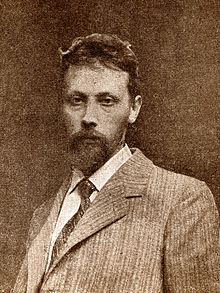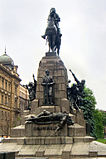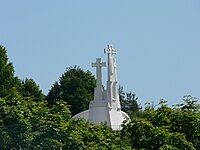Antoni Wiwulski
Antoni Wiwulski | |
|---|---|
 Antoni Wiwulski ca. 1910 | |
| Born | 20 February 1877 |
| Died | 10 January 1919 (aged 41) |
| Nationality | Polish and Lithuanian |
| Known for | Sculpture |
| Notable work | The Grunwald Monument in Kraków, 1910 Three Crosses in Vilnius, 1916 |
Antoni Wiwulski (Lithuanian: Antanas Vivulskis; 20 February 1877 – 10 January 1919) was a Polish-Lithuanian architect and sculptor.[1][2][3]
Biography
He was born 20 February 1877 in Totma, in Russia, where his father Antoni, veteran of the January Uprising of 1863, served as a forest superintendent.[4] Both parent were born in Samogitia, his mother Adelajda Karpuszko was able to speak in Samogitian. Antoni Wiwulski graduated from the gymnasium in Mitau, and later from the reputable Jesuit boarding school in Khyriv. He graduated in 1897[5] and then two of the most prestigious art and architecture universities of the epoch: the École Supérieure des Beaux-Arts in Paris and the Higher Technical School in Vienna. His work was part of the sculpture event in the art competition at the 1912 Summer Olympics.[6]
Among the most notable of his works are:
- the Grunwald Monument in Kraków, Poland
- Chapel in Šiluva, Lithuania
- Three Crosses on the Hill of the Three Crosses Vilnius, Lithuania
- the Holy Heart of Jesus' Church in Vilnius, Lithuania
The Holy Heart of Jesus' Church was started in 1913 and was the first example of usage of reinforced concrete in the former Polish–Lithuanian Commonwealth. Wiwulski, impressed by the possibility of building gigantic buildings with the newly rediscovered material prepared a project of a giant church with a stylised gigantic sculpture of the Creator sitting on the dome. However, the project was discontinued after Wiwulski's death on 10 January 1919.
In 1919, despite suffering from tuberculosis, he volunteered for the Polish militia (Self-Defence of Lithuania and Belarus) and took part in the defence of Vilnius against Bolshevik assault in the early stages of the Polish-Bolshevik War campaigns. He contracted pneumonia while on guard in the Vilnius' suburb of Užupis.[7][8] After his death he was buried in the cellars beneath the church he had designed. When it was converted by the Soviets into a Palace of the Construction Workers in 1964 his ashes were moved to Rasos Cemetery.[9]
Gallery
-
The Grunwald Monument commemorating the 500th anniversary of the Battle of Grunwald in Kraków, Poland
-
Tomb of Antoni Wiwulski in Rasos Cemetery
-
Siluva Chapel
See also
References
- ^ Phillips, Charles (1933). Paderewski - The Story of a Modern Immortal. The Macmillan Company. p. 280. ISBN 0-306-77534-4.
- ^ Tomas Venclova (2006). "Vilnius/Wilno/Vilna: The Myth of Division and the Myth of Connection". In Cornis-Pope, Marcel; Neubauer, John (eds.). History of the Literary Cultures of East-Central Europe: Junctures and disjunctures in the 19th and 20th centuries. Vol. 2. John Benjamins Publishing. pp. 22–23. ISBN 9789027293404. According to Venclova, Wiwulski represented "the Wilno variant of Polish modernism" and "considered himself to be both a Polish and a Lithuanian artist."
- ^ "Antanas Vivulskis". VLE (in Lithuanian). Mokslo ir enciklopedijų leidybos centras. Retrieved 18 June 2022.
- ^ Stefański, Krzysztof (2003). "Polish ecclesiastical architecture of the early 20th century - between the new form and national obligation". Centropa: A Journal of Central European Architecture and Related Arts. 3 (3): 249.
- ^ Korotyński, Władysław. "Antoni Wiwulski". Kurjer Warszawski. 193 (8–10) – via polona.pl.
- ^ "Antoni Wiwulski". Olympedia. Retrieved 22 July 2020.
- ^ Wiktor Zenonowicz (1986). "Rys życia autora wileńskich Trzech Krzyży (A sketch on the author of Three Crosses)". Nasza Gazeta (in Polish). 8 (547). Archived from the original on 30 November 2005. Retrieved 10 July 2006.
- ^ J. Polonus (July 2005). "Grunwaldzkie uroczystości (Anniversary of Grunwald)". Źródło (in Polish). 705 (27): 31–33. Archived from the original on 4 May 2007. Retrieved 10 July 2006.
- ^ Katarzyna Deptuła (April 2001). "Cmentarz na Rossie (Rasos Cemetery)". Gazeta Wyborcza (in Polish). Archived from the original on 16 July 2007. Retrieved 10 July 2006.
Further reading
- Nijolė Lukšionytė-Tolvaišienė (2002). Antanas Vivulskis: Tradicijų ir modernumo dermė [Antanas Vivulskis (1877-1919): Synthesis of Traditions and Modernity] (in Lithuanian). Vilniaus dailės akademijos leidykla (Vilnius Academy of Arts Press). ISBN 9986571790.
- 1877 births
- 1919 deaths
- People from Totemsky District
- People from Totemsky Uyezd
- 20th-century sculptors
- Lithuanian architects
- Lithuanian sculptors
- 20th-century Polish architects
- Polish sculptors
- Polish male sculptors
- TU Wien alumni
- Olympic competitors in art competitions
- Burials at Rasos Cemetery
- Deaths from pneumonia in Poland




